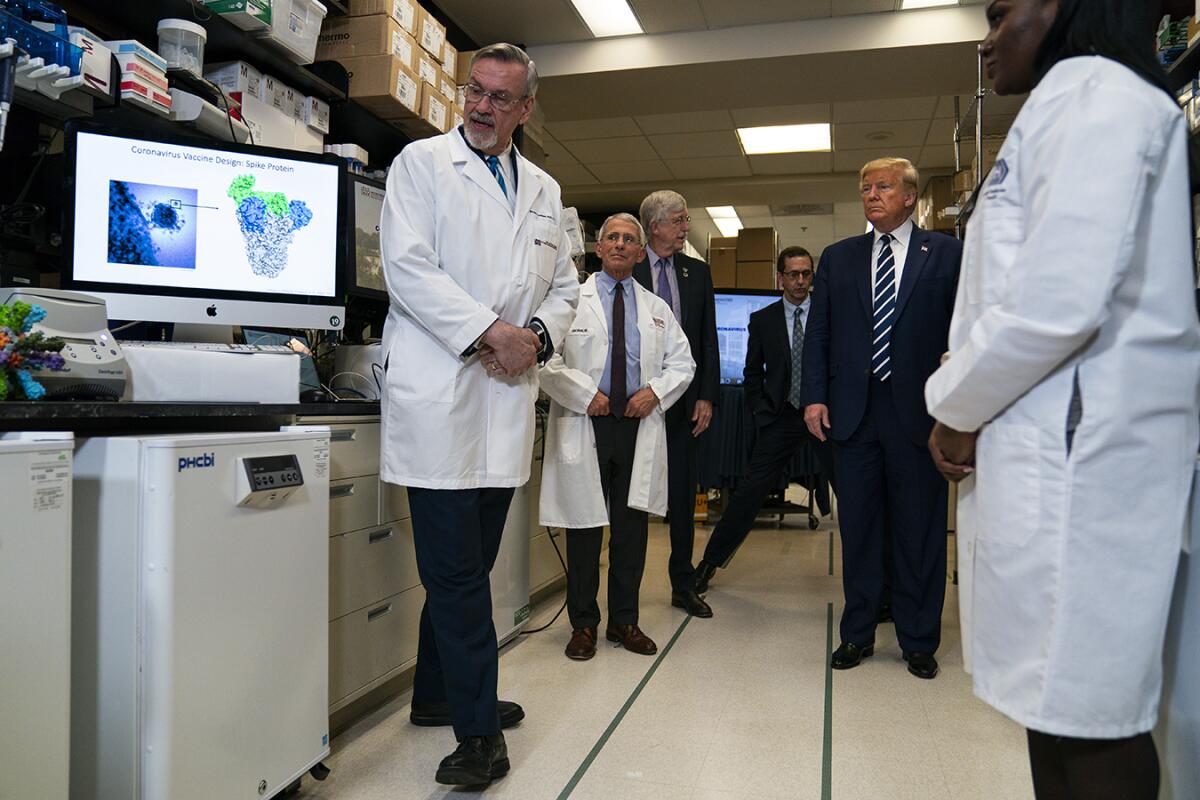Many U.S. health experts underestimated the coronavirus — until it was too late

A year ago, while Americans were finishing their holiday shopping and finalizing travel plans, doctors in Wuhan, China, were battling a mysterious outbreak of pneumonia with no known cause.
Chinese doctors began to fear they were witnessing the return of severe acute respiratory syndrome, or SARS, a coronavirus that emerged in China in late 2002 and spread to 8,000 people worldwide, killing almost 800.
The disease never gained a foothold in the U.S. and disappeared by 2004.
But SARS cast a long shadow that colored how many nations — and U.S. scientists — reacted to its far more dangerous cousin, the novel coronavirus that causes COVID-19.
When Chinese officials revealed that their pneumonia outbreak was caused by another new coronavirus, Asian countries hit hard by SARS knew what they had to do, said Dr. Amesh Adalja, a senior scholar at the Johns Hopkins Center for Health Security. Taiwan and South Korea had already learned the importance of a rapid response that included widespread testing, contact tracing and isolating infected people.
The U.S., by contrast, had learned all the wrong lessons.
This country’s 20-year run of good luck with emerging pathogens —including not just SARS, but also the relatively mild H1N1 pandemic, Middle East respiratory syndrome, Ebola, Zika virus and two strains of bird flu — gave us a “false sense of security,” Adalja said.
Many leading infectious disease specialists here underestimated the fast-moving outbreak in its first weeks and months, assuming that the United States would again emerge largely unscathed. American hubris prevented the country from reacting as quickly and effectively as Asian nations did, Adalja said.
A reporter who covered an Ebola outbreak in West Africa discovers troubling parallels in the U.S. over the coronavirus, including conspiracy theories and denial.
During the first two decades of this century, “there were a lot of fire alarms with no fire, so people tended to ignore this one,” said Lawrence Gostin, director of Georgetown’s O’Neill Institute for National and Global Health Law, who acknowledged he underestimated the virus in its first few weeks.
Back in January, Dr. William Schaffner was one of many who warned that the real danger to Americans was the common flu, which can kill up to 61,000 Americans a year.
“Coronavirus will be a blip on the horizon in comparison,” said Schaffner, a professor of preventive medicine and health policy at Vanderbilt University Medical Center. “The risk is trivial.”
Dr. Paul Offit, who led development of a rotavirus vaccine, predicted that the coronavirus, like most respiratory bugs, would fade in the summer.
“I can’t imagine, frankly, that it would cause even one-tenth of the damage that influenza causes every year in the United States,” Offit told Christiane Amanpour in a March 2 appearance on PBS.
Caitlin Rivers, an epidemiologist and assistant professor at the Johns Hopkins Bloomberg School of Public Health, worried — and tweeted — about the novel coronavirus from the beginning. But she says public health officials try to balance those fears with the reality that most small outbreaks in other countries typically don’t become global threats.
“If you cry wolf too often, people will never pay attention,” said epidemiologist Mark Wilson of the University of Michigan School of Public Health.
Many experts fell victim to wishful thinking or denial, said Dr. Nicole Lurie, who served as assistant secretary for preparedness and response during the Obama administration.
“It’s hard to think about the unthinkable,” Lurie said. “For people whose focus and fear was bioterrorism, they had a worldview that Mother Nature could never be such a bad actor. If it wasn’t bioterrorism, then it couldn’t be so bad.”
Had more experts realized what was coming, the nation could have been far better prepared. The U.S. could have gotten a head start on manufacturing personal protective equipment, ventilators and other supplies, said Dr. Nicholas Christakis, author of “Apollo’s Arrow: The Profound and Enduring Impact of Coronavirus on the Way We Live.”
“Why did we waste two months that the Chinese essentially bought for us?” asked Christakis, a physician and sociologist at Yale. “We could have gotten billions of dollars into testing. We could have had better public messaging that we were about to be invaded. … But we were not prepared.”
Dr. Anthony Fauci, the nation’s top infectious disease official, isn’t as critical. He said there was no way for scientists to predict how dangerous the coronavirus would become, given the limited information available in January.
“I wouldn’t criticize people who said there’s a pretty good chance that it’s going to turn out to be like SARS or MERS,” said Fauci, director of the National Institute of Allergy and Infectious Diseases, noting this was “a reasonable assumption.”
Solutions are always clearer in hindsight, Fauci said, adding that public health authorities lose credibility if they respond to every new germ as if it’s a national disaster. He has repeatedly said scientists need to be humble enough to recognize how little we still don’t know about this new threat.
“You can say we should have shut things down much earlier because of silent spread in the community,” Fauci said. “But what would the average man or woman on the street have done if we said, ‘You’ve got to close down the country because of three or four cases?’”
When did you realize that the COVID-19 pandemic would profoundly alter your life? For this reporter, it was the last week of February 2020.
Scientists say their response to the novel coronavirus would have been more aggressive if people had realized how easily it spreads, even before infected people develop symptoms — and that many people remain asymptomatic. “For a virus to have pandemic potential,” Adalja said, “that is one of the greatest assets it can have.”
Although the coronavirus has a lower mortality rate than SARS and MERS, its ability to spread silently makes it more dangerous, said Dr. Kathleen Neuzil, director of the Center for Vaccine Development at the University of Maryland School of Medicine.
People infected with SARS and MERS are contagious only after they begin coughing and experiencing other symptoms. “When people got sick,” Christakis said, “they got sick pretty badly and went right to the hospital and weren’t walking around transmitting it.”
Based on their knowledge of SARS and MERS, which are also caused by coronaviruses, doctors initially believed they could contain the new virus by telling sick people to stay home. Furthermore, there appeared to be no need for healthy people to wear masks. That led health officials, including U.S. Surgeon General Jerome Adams, to admonish Americans not to buy up limited supplies of face masks, which were desperately needed by hospitals.
Many scientists were skeptical of early anecdotes of pre-symptomatic spread. But as evidence of pre-symptomatic spread accumulated, the Centers for Disease Control and Prevention in April changed its advice and urged Americans to mask up in public.
The CDC’s initial advice against wearing masks was based on research that found them to be ineffective against spreading influenza, Adalja said. New research, however, has shown masks reduce the transmission of the novel coronavirus, which spreads mainly through respiratory droplets but can travel in the air as tiny particles.
If nearly all Americans would wear face masks when they leave their homes, they could save over 100,000 lives by the end of February, a study says.
Adalja said the U.S. should have learned from its early stumbles. Yet in spite of abundant evidence, many communities still resist mandating masks or physical distancing.
“I continue to be baffled that we keep making the same mistakes,” Adalja said. “It’s almost like we’re doomed to repeat this cycle endlessly.”
There were experts who immediately recognized the threat from the novel coronavirus.
One of them was Dr. Daniel Lucey, an adjunct professor of infectious diseases at Georgetown University Medical Center. In a Jan. 7 post on a website of the Infectious Diseases Society of America, Lucey labeled the pneumonia “Disease X,” using the WHO’s term for an emerging pathogen capable of causing a devastating epidemic, for which there are no tests, treatments or vaccines.
Adalja was another early voice of concern. He began blogging about the virus about the virus on Jan. 20.
“We had to immediately react as if this were going to hit every corner of the Earth,” he said. It was clear “this was not a containable virus.”
He would know. In 2018, he led a project to identify the features that allow emerging viruses to become pandemic. He and his co-authors highlighted the threat of certain respiratory viruses that use RNA as their genetic material.
Today, when a deadly virus explodes out of nowhere, geneticists are indispensable players in the international game of whodunit. Here’s how they help.
The more Adalja learned about the novel coronavirus, the more it seemed to embody the very type of threat he had warned about: one with “efficient human-to-human transmissibility, an appreciable case fatality rate, the absence of an effective or widely available medical countermeasure, an immunologically naïve population, virulence factors enabling immune system evasion, and respiratory mode of spread.”
Although the CDC set the wheels of its response in motion early, establishing an incident management structure on Jan. 7, the agency bungled its approach to testing. The outbreak escalated rapidly, leading the World Health Organization to declare a health emergency on Jan. 30 and the U.S. to announce a public health emergency the next day.
Adalja and other experts dismissed some of the Trump administration’s early responses, such as quarantines and a travel ban on China, as “window dressing” that “squandered resources” and did little to contain the virus.
Lucey noted that the international response was hampered by misinformation from Chinese officials. “The Chinese government said there was no person-to-person spread,” he said. “That was a lie.”
When China revealed on Jan. 20 that 14 health workers had been infected, Lucey knew the virus would spread much farther. When the number of infected health workers grew to 1,716 on Feb. 14, “I almost threw up.”

At the National Institute of Allergy and Infectious Diseases, scientists had been studying the protein structure of coronaviruses for years.
Researchers had developed a vaccine against SARS, Fauci said, although the epidemic ended before researchers could test it widely in humans.
“We put the vaccine in cold storage,” he said.
Dr. Barney Graham, deputy director of the National Institutes of Health’s Vaccine Research Center, asked Chinese scientists to share the coronavirus’ genetic information. After the genome was published, Graham went immediately to work.
Although Graham’s team worried about how to pay for the research, Fauci said he told them, “Don’t worry about the money. I’ll find it.”
That work was instrumental in developing the two COVID-19 vaccines now being rolled out across the country.
Health experts hope the U.S. will learn from its mistakes. For Dr. Tom Frieden, who led the CDC during the Obama administration, the most important lesson is that “we can’t be this unprepared again.”
“This should be the most teachable moment of our lifetime,” he said, “in terms of the need to strengthen public health in the United States and globally.”
Dr. Céline Gounder, an infectious disease specialist advising President-elect Joe Biden, said that given how many novel viruses had emerged in the past two decades, it’s likely that “pandemics are going to become more frequent.” Yet U.S. public health funding tends to follow a cycle of crisis and neglect.
“We tend to invest a lot in that moment of crisis,” Gounder said. “When the crisis fades, we cut the budget. That leads us to be really vulnerable.”
Liz Szabo writes for Kaiser Health News, a nonprofit news service covering health issues. It is an editorially independent program of the Kaiser Family Foundation that is not affiliated with Kaiser Permanente.










